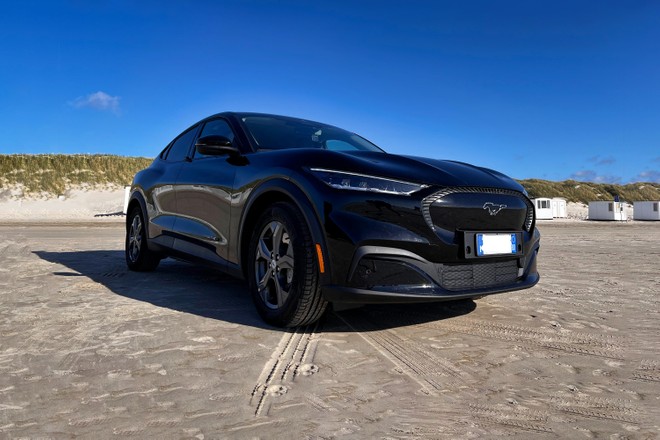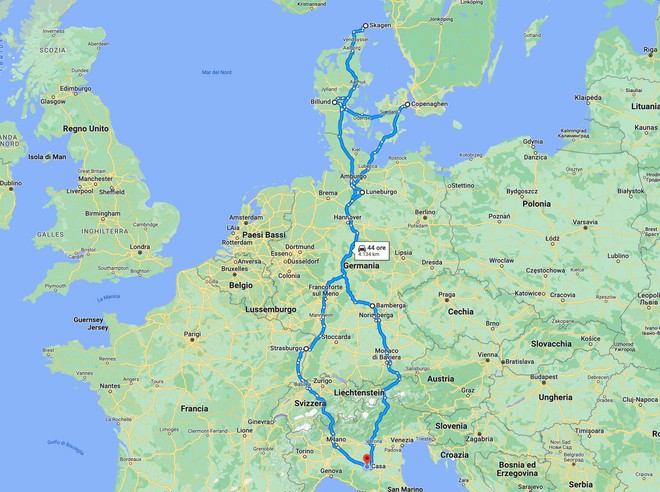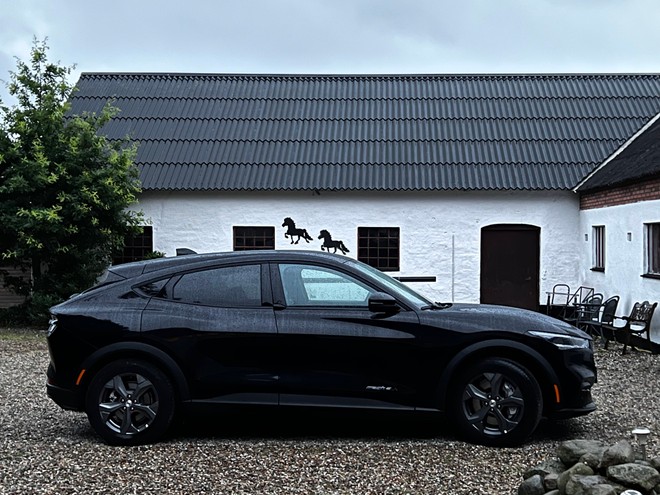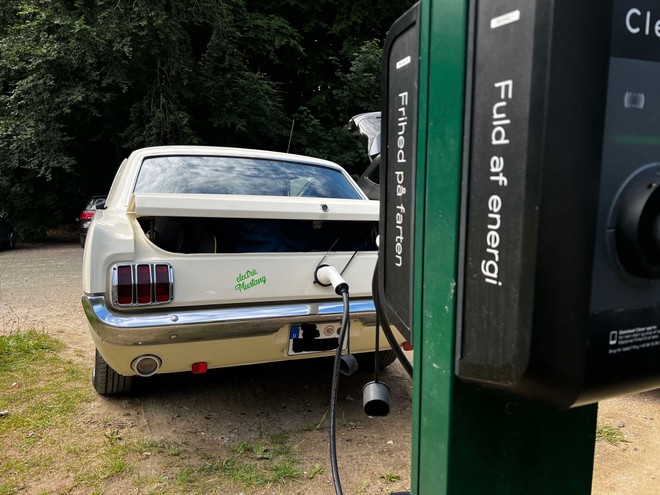
Take a family of five (myself included) who are keen to get back on the road after two summers of pandemic, and put it on board an electric car . Direction: Denmark . A choice not by chance, a mix between the desire to visit a beautiful area with lush countryside and cities; rich in history and will to reach a country in electricity that in December last year for the first time sold more; electric and plug-in and endothermic cars (data De Danske Bilimport & oslash; rer).
The one of these lines wants to be the story of how managed to reach the goal – and above all to go home! – aboard the Mustang Mach-e purchased last year (you can find our review HERE), 98.8kWh Extended Range rear-wheel drive model with autonomy according to the WLTP cycle of 610km. & Eacute; a purely experiential account that does not want to be n & eacute; exhaustive, n & eacute; technician – I have much more colleagues; good of me on these aspects – but who intends to testify how it is actually possible to use an electric car well beyond mere city borders . Of course, the pros are added to the cons of this choice, which you must be aware of before leaving as it is; to avoid easy jitters and unexpected delays on the road surface.
- THE JOURNEY
- SPACE BY CAR: PASSENGERS AND LUGGAGE
- REFILLS
- TIME TAKEN AND STRATEGIES
- WHICH APP TO RELY ON
- CONSUMPTION AND EXPENDITURE
- CONCLUSIONS
- PROS AND CONS
- VIDEO
THE JOURNEY 

Let's start with some data on the trip:
- car: Mustang Mach-e RWD Extended Range
- route: Reggio Emilia-Denmark (furthest point: Skagen)
- route: gone via Switzerland, with stops in Strasbourg and northern Germany. Return via Germany and Austria
- total km traveled: approximately 4,400 (4,134 are counted on the map, to these must be added others for short trips during the journey)
- people on board: 5 (2 adults, 3 children)
SPACE IN THE CAR: PASSENGERS AND LUGGAGE 

Before talking about expenses, consumptions and top-ups, I think it's right to make a point of of Mach-e to carry 5 people and related baggage. It is clear that both the first and the second data depend on the type of person/family who travels. In my case it is 2 adults and 3 children, two of whom seated on a booster and one (one) on a 9-18kg seat. So the rear seats were occupied by people of small stature and build, but we also take into account the fact that both the boosters and the seat take up a lot of space horizontally. All three children traveled comfortably, thanks also to the absence of the central tunnel that makes s & igrave; that the car floor is completely flat. A small note on the central seat, generous in size but whose rigidity – especially in the backrest – has partly affected its actual comfort.
For this reason; which concerns baggage , well, this is; a variable that is difficult to judge as it is extremely subjective: c & # 39; & egrave; whoever leaves with the whole house on board, there is instead those who limit themselves to the essential (trusting in the operation of washing machines in the houses rented along the way). We have chosen this second option: it is not; It is possible to add a luggage rack on the roof (infamous choice for aerodynamics, but sometimes indispensable despite the higher consumption) as Ford does not provide it – n & eacute; provides the possibility & agrave; to install the bars, but the frunk is precious (very precious)(front trunk), i.e. the front trunk. Ford sells the Mustang Mach-e with a divider inside this 100 liter cockpit, making it useful for carrying everyday groceries but not for such a trip. Paying particular attention not to break the plastic screws, I managed without too many worries to remove the dividers and found myself in this way; a fully usable frunk. To its 100 liters are added the 402 liters of the rear trunk .
To optimize space, I placed the curtain that hides the luggage under the shelf, so it is; to exploit the most space is also possible vertically, in any case leaving free the view from the rear-view mirror. 5 suitcases, 4 backpacks, 3 bags, a thermal bag and the stroller were placed without problems inside the car, dividing them between frunk and rear trunk and leaving the passenger compartment completely free from annoying flying bags .
REFILLS 
One account & egrave; recharge the car at home or in the columns that “in the meantime I know where they are, if they work and how much they cost”, another one & egrave; travel with the hope that everything goes according to plan. The trip required additional planning compared to what many (not all) do before leaving, because & eacute; however the stages must be decided (also) on the basis of the autonomy of the vehicle and the overall travel times. Part of the programming is; was performed before leaving , but I must say that the most & egrave; it was done in itinere , either the night before or the morning before getting into the car. Objective: to reach the goal without staying on foot based on the percentage indicated on the screen.
Yes, better look at the percentage and not the km of autonomy , because & eacute; the first is; pure data, the latter are variables that change according to the driving style, whether the route is uphill or downhill, the traffic and the type of road and speed. One account & egrave; traveling at 90km/h on a state road, another is; speeding at 140km/h on German motorways where there are no limits. In general, on extra-urban roads I have always kept an average of 80km/h (as per the signs in the various countries crossed), on the motorway the average is; was about 110-115km/h to try to optimize consumption.
 C '? who has a particular Mustang …
C '? who has a particular Mustang …
Let's start by saying that s & igrave ;, the columns exist , even if their diffusion varies according to the country taken into consideration. And not only that: another important factor is; the signs . An account in fact & egrave; search for them on Google Maps, Apple Maps, Mach-e proprietary navigator or any other application, another & egrave; find them easily along the motorway route. In short:
- Switzerland : indicated very well with the word EV on service station signs. Practically the columns are in almost all the service areas.
- France : indicated little and badly. Fortunately, I didn't need to recharge during the (short) trip to France, but the columns can only be reached with the help of some app.
- Germany : indicated well with the drawing of a petrol pump with electric socket. They are not always present in all the distributors along the highways, in addition & ugrave; in Germany the service areas are less frequent than in Italy and very often they are located outside the motorway itself: in practice, you have to exit to access them (NB: the German motorways are free, therefore there are no toll booths) .
- Denmark : very well indicated and well distributed along the motorways. In practice, for each distributor there are at least a couple of charging stations.
- Austria : indicated discreetly and not particularly frequent.
- Italy : for this trip I had the opportunity to refuel at Ionity of Trento, outside the AutoBrennero. No indication, only the apps (Ford Pass first of all, but also all the others) guided me to that point. Unlike all the other stalls used during the trip, in Trento there was no station for drinking, eating or going to the bathroom. Uncomfortable.
The vast majority of the columns positioned along the highways are; a fast recharge, at least equal to or greater than 50kW . With Ionity you reach 150kW : for this reason (and for the fact that for 1 year Ford offers free access to the brand's columns at a discounted rate – 0.33 euros/kW instead of eacute; 0.79) my choice fell mainly on these. At least l & agrave; where they were present (many in Denmark).
TIME TAKEN AND STRATEGIES 

The strategy is simple: try to match the breakfast, lunch or snack break with the recharge . In 99% of cases, next to the columns (on the motorway) there were service stations with relative bar/restaurant. It must be taken into account that, although it is always better to charge up to 80% to preserve the battery and make it last longer; long, traveling & egrave; & quot; allowed & quot; go 100% like this; to have more autonomy. At home I recharge at 4/5, on vacation I prefer to fill up. Even the speed charging affects the health of the battery, but in these cases it is preferable to give priority; to speed. And the columns optimize speed; charging based on the percentage reached: it starts slowly until it reaches the peak around 50-60% (150kW in my case), and then collapses to 7kW after 95%.
In practice, yes consider about an hour to go from 25-30% to 98-99% . & Eacute; really time for a break – maybe a little bit more longer than usual, but I have learned to appreciate it because & eacute; relaxes your nerves by forcing you to do nothing but wait, perhaps with a coffee; to sip. More times I & egrave; happened to repeat the recharge even in the afternoon, perhaps for a shorter time – half an hour, just to reach the goal.
Different speech for the evening refills, when you & egrave; already settle into the house booked on Airbnb or the Booking.com hotel. Only in one case did the hotel have recharges: 14 – I say fourteen – Supercharger stalls for Tesla. Stop. In general, cities that I visited were full of columns. The only thing was to find the compatible and working one: once identified, it was enough to leave the car attached with its cable for a few hours, just the time for dinner and a walk. As you can see, the password for electric is tuck-up .

Another topic concerns the find the columns in the cities/towns . Denmark has many located everywhere, but the problems I encountered are the following:
to find them you need apps : apps don't always say the same thing! On one of the columns there is and & egrave; free, on another there is but & egrave; busy or out of order, on another still there is no own. It all depends on the supplier circuit provided by the app. More late say & ograve; to whom I have relied most.
they are not always & quot; compatible & quot; : be careful to sing victory once you & egrave; parked the car in front of the column. If these are not from the Ford circuit there could be communication problems with the car, and sometimes not even the evWay lifesaving tokenme & egrave; enough. In those cases I have tried to download the provider's app, but sometimes the sign up process is not completed successfully because personal data are not accepted (for example, there is no postal code of one's Italian city of residence because only the postal codes of Germany or Denmark are provided). And even with the payment system I often got stuck. Result: I instantly uninstalled the app (which meanwhile took part of my data) and, muttering, I went back to driving the Mach-e looking for another column.
in the city & agrave; they are slow (generally 22kW): and this can be; also be a plus, because & eacute; so & igrave; you can & ograve; leave the car all night. In Denmark, electric cars park for free almost everywhere – after inserting the license plate in the payment columns, so & igrave; that the car is registered in the system.
WHICH APP TO RELY ON 

Here the unique answer does not exist . After several tests and attempts, my point of reference is; gradually become more and more; Ford's infotainment system , perhaps not immediately intuitive but which, once digested, allows you to promptly view the columns along the way. If you also enter the destination, the columns where you can stop and recharge are shown on the map, showing the stop time and the consequent arrival time at the destination.
In short, the best option obvious had been the one that I had initially discarded, either because & eacute; attracted by Google Maps or by the integrated functions of Apple Maps for electric cars, either because & eacute; I believed that the various evWay, ChargeMap and the like would have offered me more answers; punctual. The most Sometimes everything worked empirically, blowing up the meticulous programs of the night before: my wife on Google Maps, me on evWay and final check on the Mach-e screen. Sometimes it didn't work, other times we had not only the first option, but also the second and third. To always be taken into consideration in case of emergency (non-functioning of the column or other).
I had also downloaded the official Ionity app, but I admit that if you & egrave; owning a Ford car is not so & igrave; useful: everything passes through the manufacturer's official app, both on smartphone and directly on the screen in the car. (NOTE on Ionity: beware of the queues, there is often to wait). Basically I relied on Ford Pass , in cases of necessity; I also used evWay – often in cities, so that I had immediately the information of the availability of a column compatible with activation via app or RFID (the evWay token). As a counter-proof there was also Google Maps, even if in the end its use is; rather marginal state.
CONSUMPTION AND EXPENDITURE 
Here there is little to romance. Here are the mere data:
- km traveled: approximately 4,400
- expenditure incurred: 400 euros
- expenditure per km traveled (average): 0, 09 euro/km
CONCLUSIONS 

We didn't always find the column at the first try (in Mannheim we ran with the battery at 3% in desperate search for a working stall), other times we queued to wait (good opportunity to meet people from other countries and to admire the different models of electric cars plugged into the plug), still others we went away with empty hands (and battery). But above all in the vast majority of cases we respected the deadlines , correctly planned the stops and recharged the Mach-e in the most suitable way; peaceful as possible. Especially with Ionity, very present along the European motorways: thanks to the Plug & amp; Charge service I didn't even have to insert cards, cards or tokens, I just had to go to the column, press Start and attack.
< img src = "/wp-content/uploads/a3166e28adb9c6fea01923bda526cff3.jpg" />
Traveling by electric is possible , & egrave; It is clear that everything depends on the type of car you buy (a car with an autonomy of 100 km is obviously very different from one that guarantees, on average, 450km like the Mach-e). And it also depends on the patience you have: recharging the car means not having anxiety and enjoying the breaks.
And you save, if you drive in mode; electric: by this I mean managing the car in such a way that maximum energy recovery is obtained (for example driving with a pedal, which I always use), driving without jerks and with a speed; not exaggerated. On the highway it wears out more, in the city & agrave; less. In the best of hypotheses I managed to cover long stretches at 16kWh/100km (on average).
PROS AND CONS with the fast columns (see Ionity) the charging time? relatively short columns well distributed in the territory along the route traveled almost all the stalls have places to eat and drink not always? indicated the charging cost per kWh there are too many platforms, none of them? complete number of columns insufficient for the number of electricity in circulation in some countries the columns are not well indicatedifficolt? to activate the top-up between apps, tokens and credit cards 
Auto 29 Nov
VIDEO
What's new? Xiaomi small and light? Xiaomi Mi 11 Lite, on offer today from Bpm power for 232 euro or from Euronics for 299 euro .